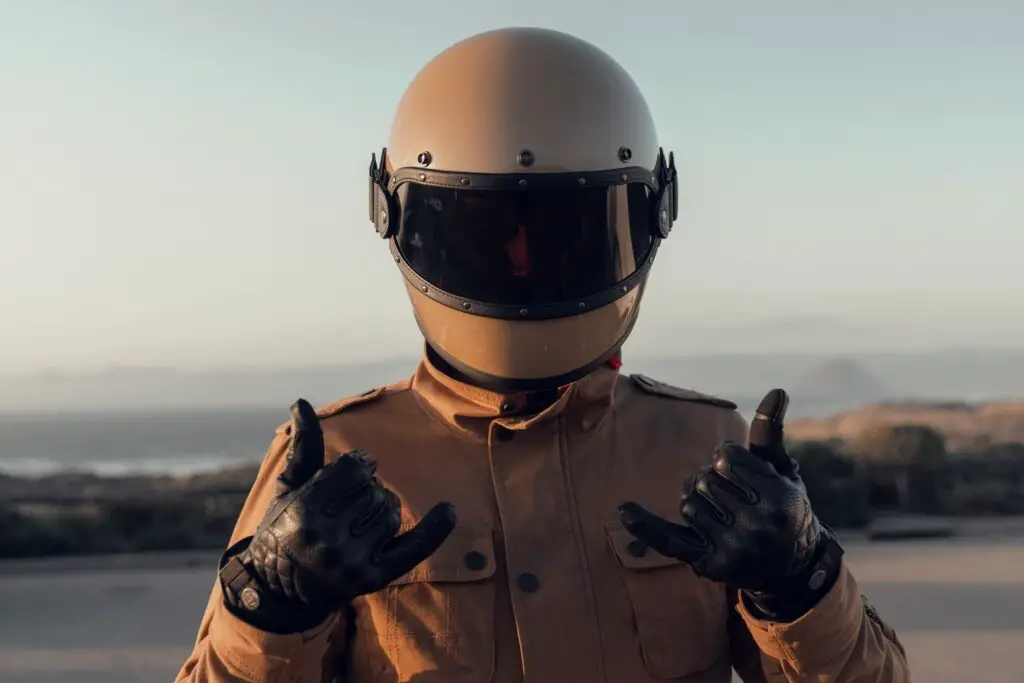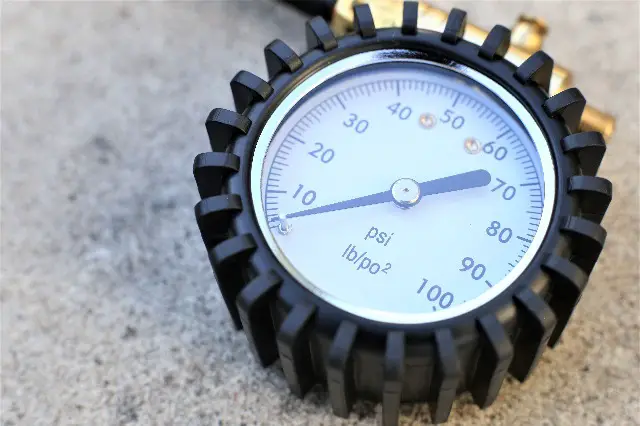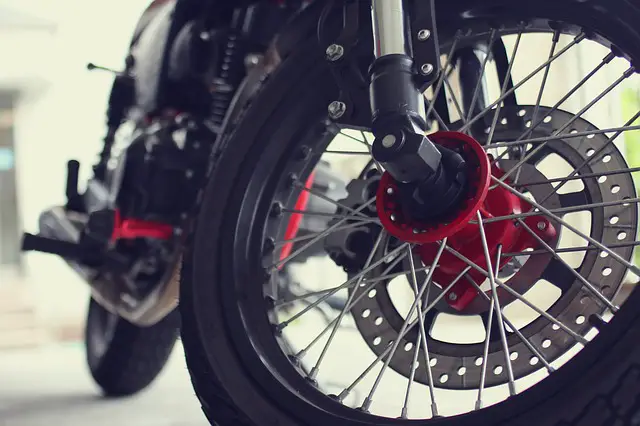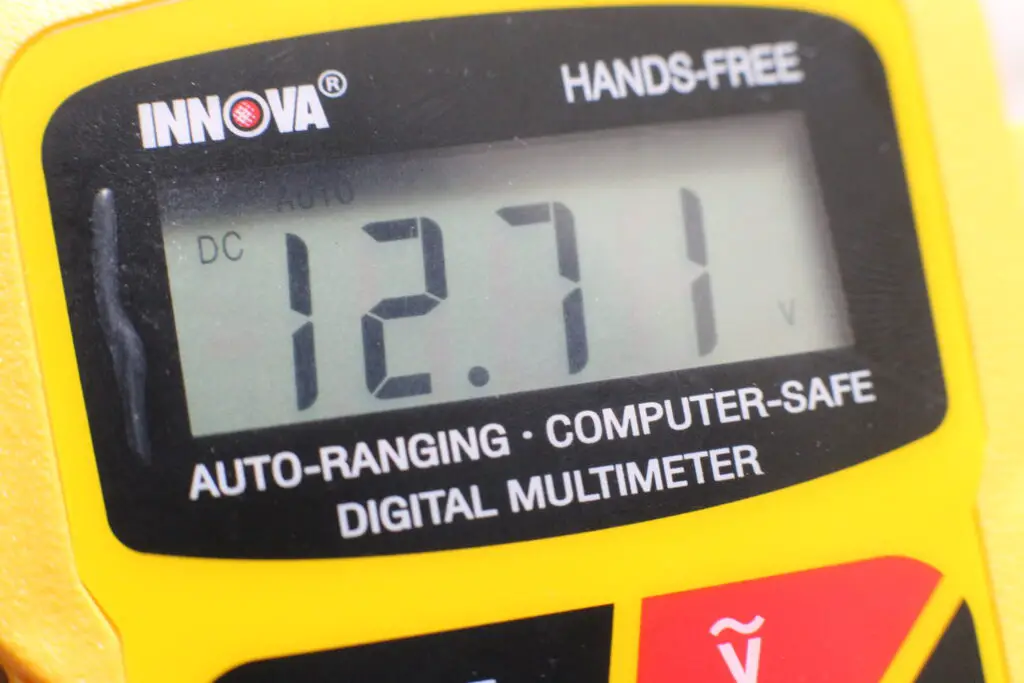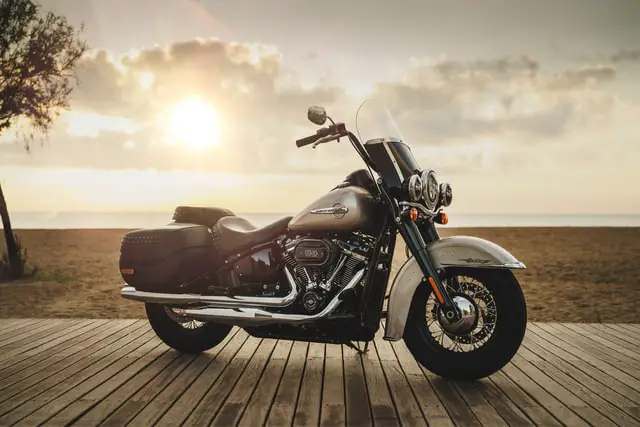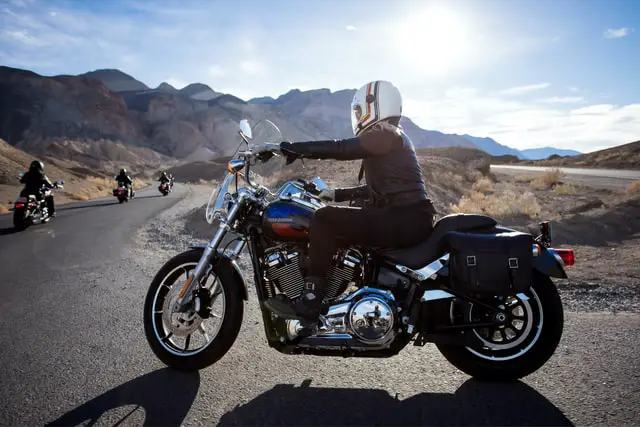In this guide, we will break down each type of motorcycle helmet, the intended purpose of each style, and their pros and cons.
What Are the Differents Motorcycle Helmet Styles Available?
There are currently six types of motorcycle helmets.
1.Full-face
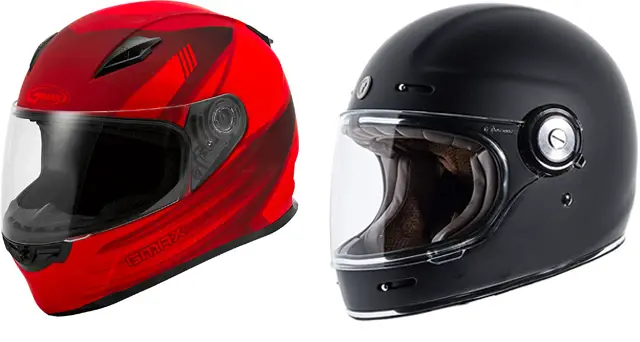
Safest helmet for road riding and track racing
2. Half-Helmet
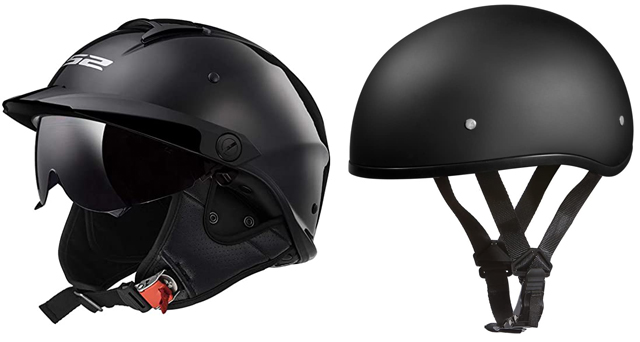
Helmet with half coverage of a motorcyclist’s head
3. Open Face
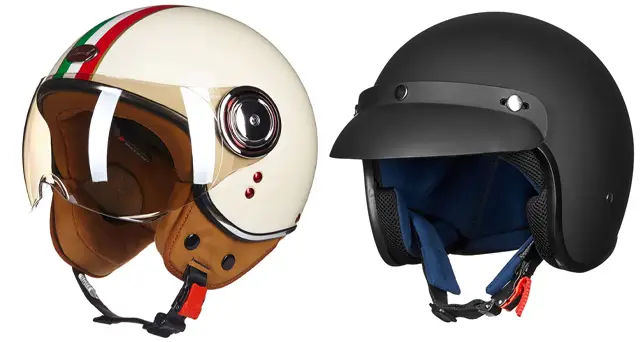
Offer better protection and coverage of a rider’s head than a half-helmet
4. Modular
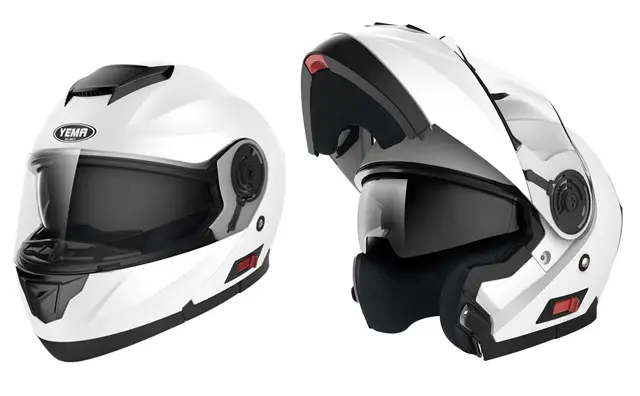
A full-face helmet that can open and flip up its front section
5. Dual-Sport
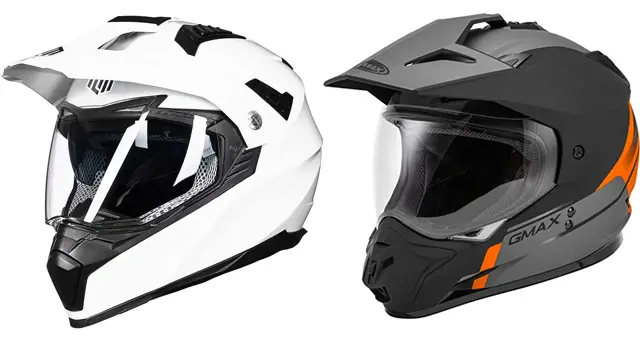
A cross between a full-face helmet and an off-road helmet
6. Off-Road
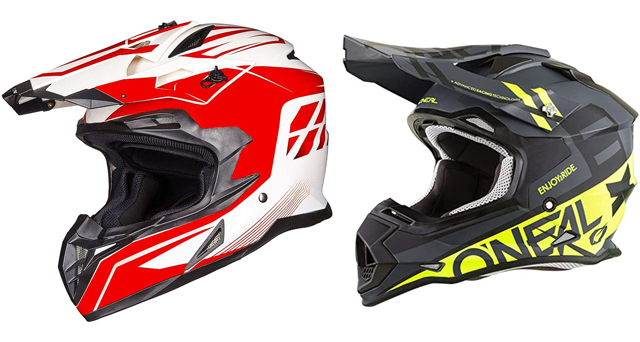
Intended for off-road riding
All motorcycle helmets share a common goal…

Their job is to prevent your head from looking like a blown-up watermelon after a motorcycle accident.
Yet some Helmet styles will offer significantly better protection than other.
Each motorcycle helmets category also provides unique utility features from one another.
It makes some styles of helmets more suited to different kinds of riding.
Full Face Motorcycle Helmets
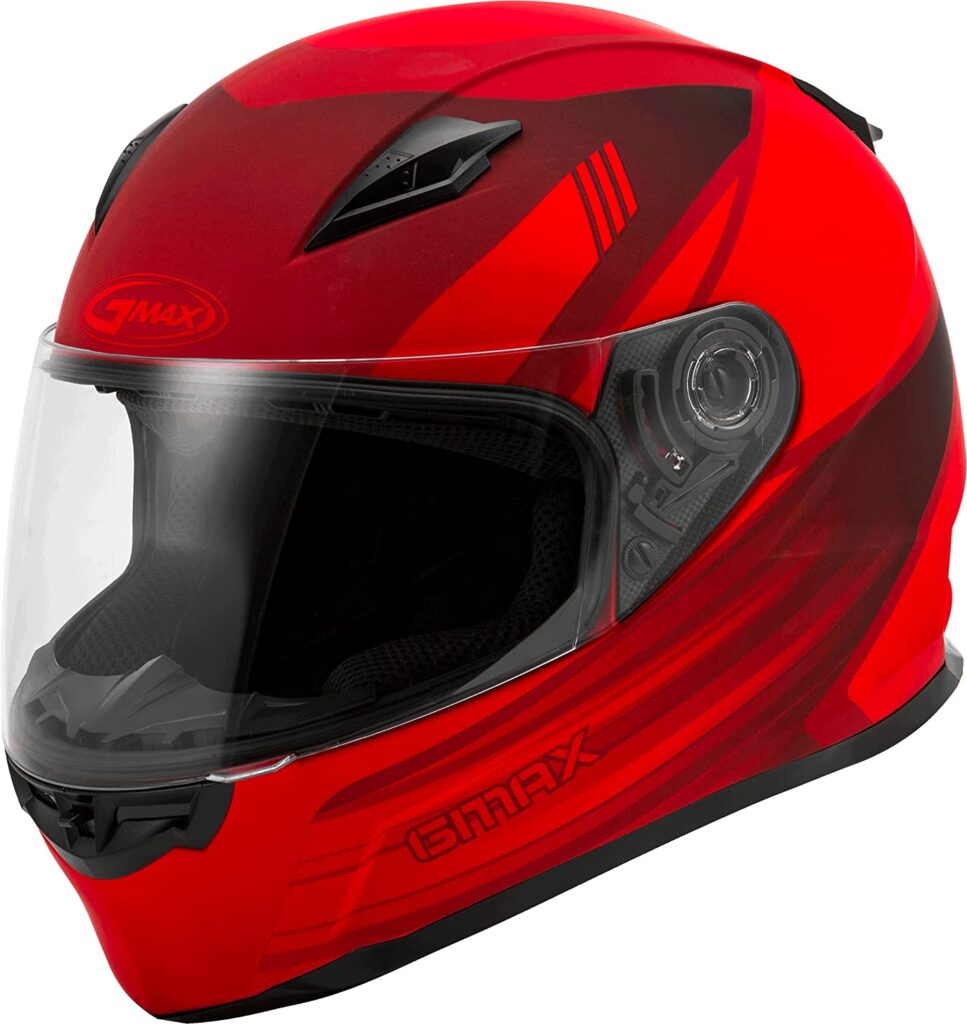
Also known as:
- Street Helmet
- Racing Helmet
Safety Rating 5/5
Intended for road riding and track racing.
Pros
- The most protective overall of the 6 helmet styles for road usage
- Many different models and looks are available
- Fair Soundproofing
Cons
- Lesser airflow to cool the user’s head.
- Fogging Issues in High humidity with the visor down.
- On the higher side of motorcycle helmet price range.
If I could look into the future, and I knew I would crash on a particular day, hand down, I would wear a Full Face-Motorcycle helmet.

Of course, nothing is perfect in this world, and full-face helmets comes with a significant drawback.
Having this kind of thing over your head can get pretty hot and uncomfortable even with all the built-in ventilation ports.
So, you could get the temptation to wear something less enclosed…
But let me show you this image.
This summarises a study on the probability of where you would hit your head in a motorcycle accident.
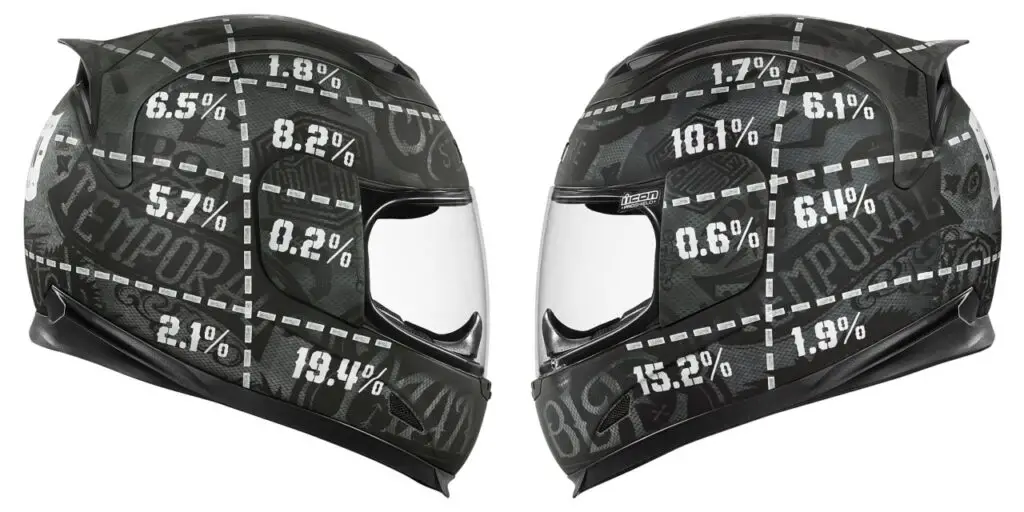
You almost have a 1 in 2 chance to smash your chin or face when going down, no matter what type of helmet you wear.
I will never wish for any biker to crash, but if that happens to you, you will be glad to have a chin bar with a full-face helmet.
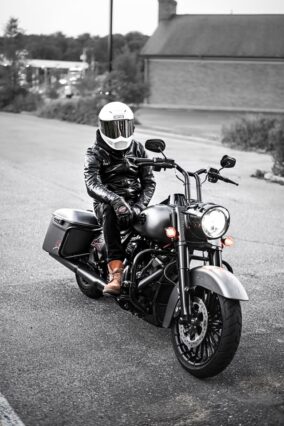
Motorcycle Half-Helmet
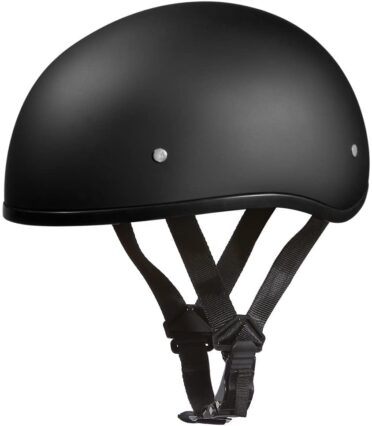
Also known as
- Brain Bucket
- Salad Bowl
Safety rating 1/5
Intended usage: Shortening a biker life expectancy
Pros
- Best Ventilation
- Best Field of View
- Lower price range
Cons
- The least protective of the 6 helmet styles.
After the full face, let look at the other side of the coin; the least protective helmet style you can get.
”Full disclaimer before I bash this style of helmet into the ground.”
I used to ride myself with a half-helmet for over one year when I started riding, and I loved it.
Riding down a twisty road with a half-helmet is a hell of a blast!
Feeling the full force of the wind when you gun the throttle and listening to your bike thundering down the road with unobstructed hearing is something else.
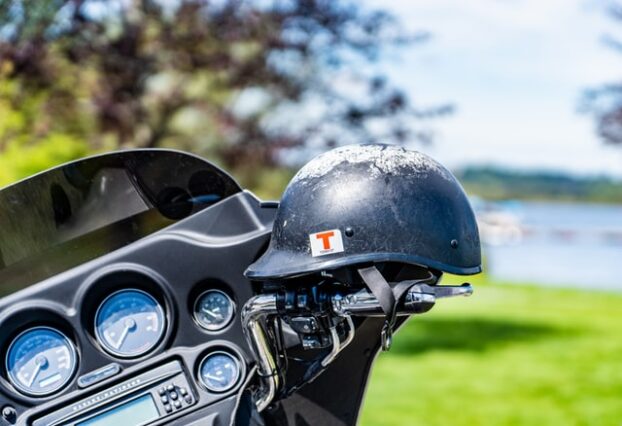
But as my riding experience increased, I concluded that I would like to stay alive if I crashed XD.
I will be honest that I strongly discourage riders from choosing half-helmet.
In my opinion, a motorcycle Half-helmet coverage of a person’s head is utterly inadequate for saving a rider’s life in a crash.
There is a reason people call them ”brain bucket”.
Yet, Half-helmets stylish traditional look is very popular with the old school crowd of bikers and cruiser riders.
Even today, they are still very popular in North America despite their poor safety ratings.
It is mainly due to the outdated and easy to obtain DOT safety certification that still allows them to be road-legal.
I bring to your attention that there are no, Half-face Helmets approved by the more rigid ECE European safety certification tests…
Kind of tell you something there.
If you ride with a Half-Face ”brain bucket” please understand that they are fun, and they give you that incredible sense of freedom while riding…
But you are playing with fire.
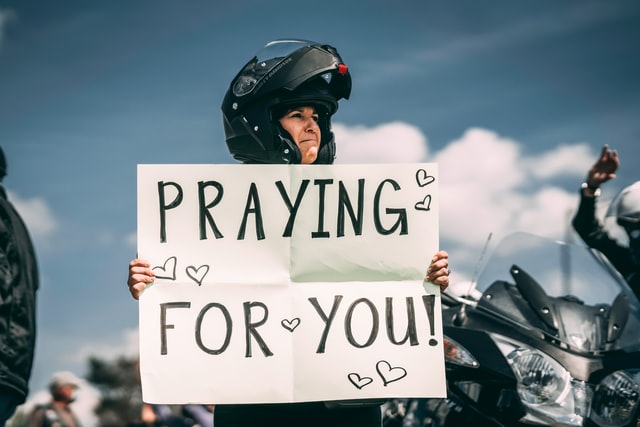
Also please wear earplugs if you put a half-helmet on your head.
Ask my diminished hearing after only one year of riding if I regret anything.
Open Face Motorcycle Helmet
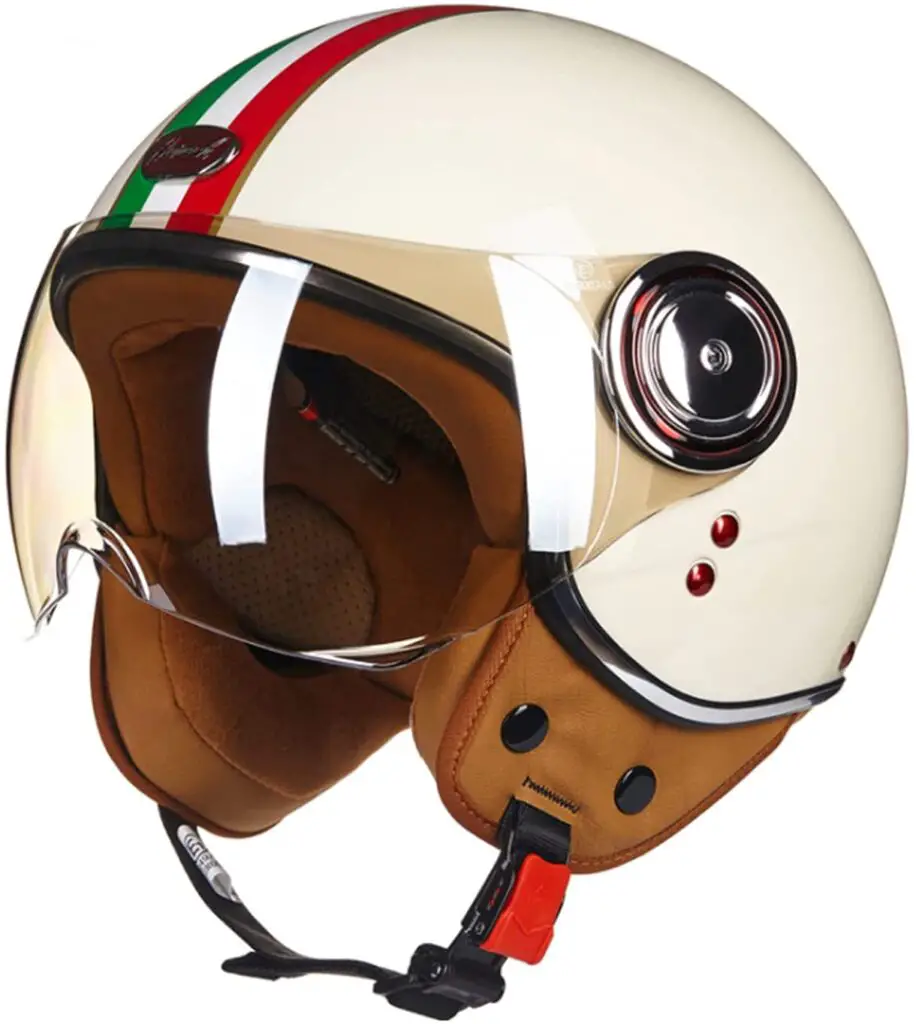
Also, known as:
- Three quarter (3/4) Helmets
- Jet Helmets
Safety rating 3/5
Intended use: Offer reasonable protection for an open field of view for street usage.
Pros
- Open field of view comparable to Half-helmet
- Decent low price Range
- More protective than half-helmet
Cons
- Do not offer chin or facial protection.
A big open field of vision with less safety compromise than a half-helmet is where open face helmets shine.
They also look cool as hell with their vintage look.
This type share a similar appearance to helmets used by fighter jet pilots hence the nickname ”Jet helmet”.
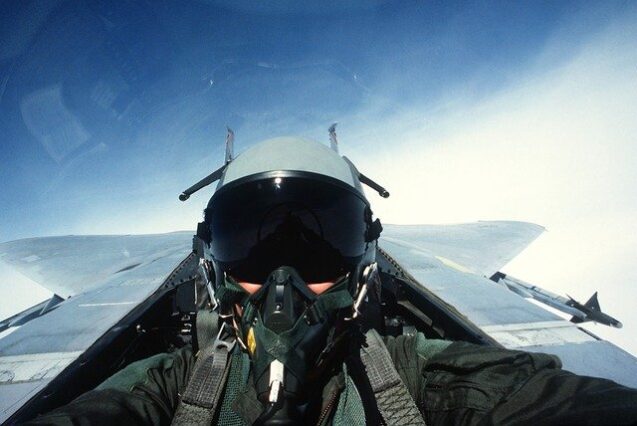
Modern open faces helmets also come with features such as a drop-down face shield, drop-visor, and faceguard.
Yet three-quarter helmets share one of the significant flaws of half-helmets brain buckets.
There is no frontal-impact crash protection for the head of the rider.
Yet, in a hard impact to the user’s face during a crash, the face shield or guard could make a difference if there is any.
But nothing beats a solid motorcycle helmet chin-bar.

And by the way, if you think growing a massive beard will act as decent facial protection against flying debris or bug…
I tried; it won’t work as well as you think. It is more a bug catcher than a bug stopper.
Ho! And that beard won’t do a darn thing against flying rocks and bumblebee-sized insects hitting your face. You will still use the F word, my dude!
But you will look insanely cool and badass will all my respect tough 🙂
Modular Motorcycle Helmet

Also known as
- Flip-up Motorcycle Helmet
Safety rating 4.5/5
Intended as a Full-face or Dual-Sport helmet that can quickly expose a user’s face without removing the helmet.
Pros
- Offer comparable protection to full-face helmet with minimal compromises
- Can open and flip up the frontal part of the helmet
Cons
- More expensive price range
- Heavier than non-modular helmets
- Similar low airflow to a full-face helmet when in the closed position
- Not recommended to ride with the helmet flipped-up
It is one of my favorite types of helmets.
The BIG thing that I enjoy about modular helmets is, of course, their main feature; The flip-up system.
It makes annoying things related to motorcycle helmets so much easier to deal with.
It a hot day, and you are stopped at the red light or stuck in traffic and want to cool off? Flip-up!
Want to talk in-person to a passing pedestrian or buddy and be heard and hear better? Flip-up!
Want to take a smoke or a sip of water real quick? Flip-up!
Also, because I am a kid at heart, and a modular helmet seems like a science fiction piece of equipment… I feel like a character in a movie or video game when I flip up my helmet!
Hey, it’s the little things in life that count to make you happy. You know one of mine now, don’t judge me. 🙂
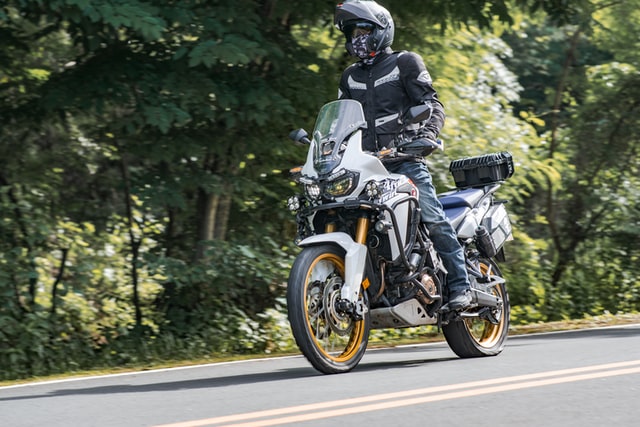
I will say, though, that as much as I like modular, they come with significant drawbacks.
The main disadvantage is that modular helmets are heavy.
The additional parts for the front of the helmet to open, swivel, and the locking mechanism will add weight to the helmet. There is no way around it.
As you ride, a heavy helmet will strain your neck muscle to the point of making you uncomfortable and increasing your overall tiredness.
It won’t be that noticeable or that bad for short afternoon rides, but it can be a problem while touring all day.
The second disadvantage of modular is that the helmet compromises a little bit of safety with additional weak spots.
The helmet is not a single solid structure piece like a true full-face, and the locking system could open on hard impact.
The third inconvenience of modular helmets is the higher price tag you have to pay for this equipment.
Although modular helmets pricing has been going down to reach a similar price range to full-face helmets in the last few years.
In my opinion, you will like modular helmets, or you won’t.
I like them since once my helmet is strapped to my head, I’m not particularly eager to take it off.
I find it annoying to remove my gloves to unstrap my helmet for the little thing like talking with a normal voice level and drinking from my water bottle.
Dual Sport Motorcycle Helmet
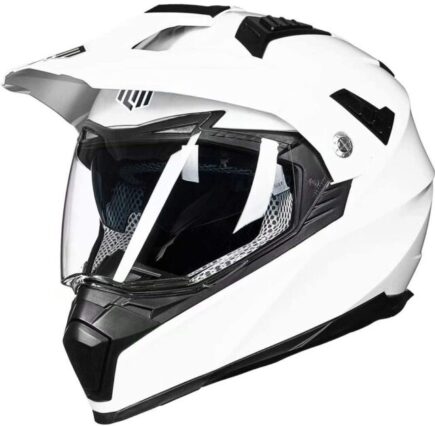
Also, known as
- Enduro Helmet
- Crossover Helmet
- ADV Helmet
- Hybrid Helmet
- Adventure Helmet
Safety rating 4.5/5
Intended usage: Versatile helmet for both road and off-road usage
Pros
- Better airflow, than a full-face helmet
- Overall better up and down field of view than a full-face
- Usually compatible for usage with off-road google
Cons
- Noisier than a regular Full face
- Not as light or ventilated as a true off-road helmet
- On the more expensive side of motorcycle helmet price range.
This helmet is the resulting baby between a Full-face Helmet and an Off-road motorcycle helmet.
The first thing that stands out with a dual-sport helmet is the sun-visor. It is a welcome addition while on the trail to block sun-blindness and deflect tree branches.
Unlike a true off-road helmet, the sun-visor on a dual-sport is more aerodynamic to reduce drag on the road.
Most dual-sport eye-port can accommodate off-road google for even better airflow.
Speaking of eye-port, on a dual-sport, the up and down field of vision will be broader and more open than a usual motorcycle full-face.
It helps a rider better see obstacles on the trail, such as rocks below, and branches above.

This helmet type also retains an off-road helmet’s extended chin bar design for additional airflow to keep a rider’s head cool when riding trails.
Better airflow is necessary while off-roading to cool off since it is a muscle-intensive activity to keep the bike balanced.
There are, of course, drawbacks to trying to make a helmet good at doing two jobs rather than being great at only doing one.
More airflow means more wind inside the helmet which, means more noise for the rider’s ears.
It is manageable at lower off-road speeds but gets ready to blast your eardrums while traveling on the highway.
A dual-sport helmet will be heavier than the specialized off-road version of a motorcycle helmet.
Going off-road with a motorcycle is a physically demanding activity, and since a dual-sport helmet is heavier, your neck muscles will work harder.
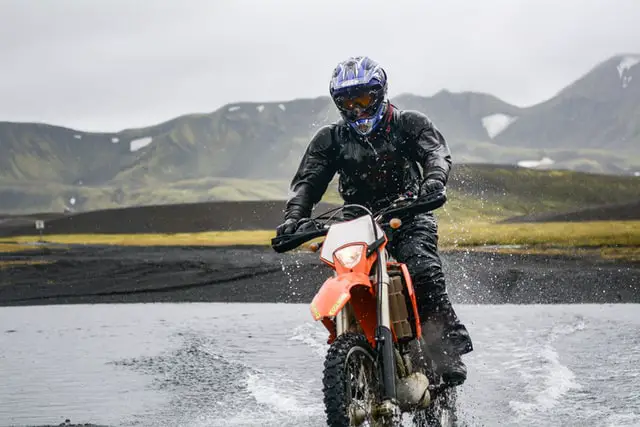
Do expect to be a little bit sore with a dual-sport helmet at the end of a demanding off-road session.
By the way, the pain is going to be worse tomorrow morning. It’s like going to the gym. 🙂
Have fun
Off-Road Motorcycle Helmet
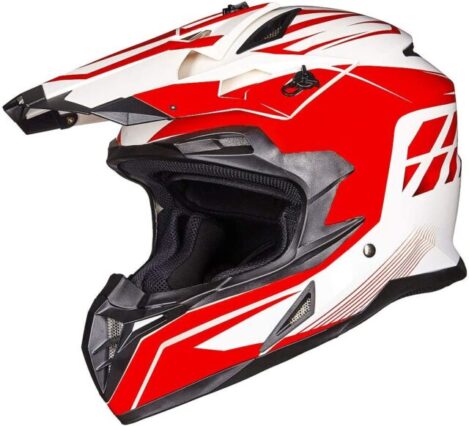
Also, known as:
- Dirt bike Helmet
- Motocross Helmet
- Dirt Helmet
Safety rating 5/5
Intended for Off-road motorcycling and moto-crossing
Pros
- Maximized airflow for an enclosed helmet
- Lightweight for a full motorcycle helmet
Cons
- Awful aerodynamic at higher roads speeds
- No soundproofing
- Require the use of external googles or glasses for eye protection
This helmet is designed for pure off-road riding.
This design maximizes lightweight, airflow, and safety at the cost of soundproofing and aerodynamic.
With the aerodynamic of this helmet intended for lower trail speed, it is unsuited for prolonged road riding.

The sun-visor will act as a parachute. The peak will drag air and constantly pressure a rider’s head to tilt up or down at higher road speed.
The extended chin-bar maximizes the airflow coming into the helmet to cool a rider-head. It, however, also generates a lot of wind sound inside the helmet.
Both the aerodynamic and non-existent soundproofing will quickly strain a rider on the road.
This helmet is king in the dirt but impractical on the pavement.
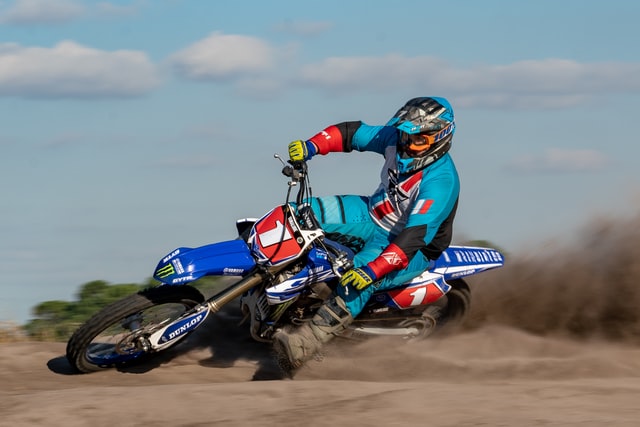
What I Recommend You Buy as Your First Motorcycle Helmet
If you have yet to complete or start your training course to get your motorcycle license, I recommend that you buy a full-face or modular as your first helmet.
I have two reasons for such a statement.
My First Reason
Statistically, in your first six months of motorcycle riding, you are at the highest percentage of chance of being involved in an accident.
There is no way around it… You will be learning and practicing motorcycle riding. It is something that is not particularly easy to master and unforgiving of mistakes.
Your lack of experience increases your probability of making these mistakes.
That is plain old good sense.
So since there is an increased risk of something bad happening, it is logical to pick up one of the most protective options.
If you don’t plan to ride off-road or run trails, Please give yourself the best survival chances and pick up a Full-Face or a Modular helmet.
As you pick up riding experience, you will know when to upgrade the helmet you already have for something more high-end or change your helmet style.
Why I Recommend a Modular as A Beginner Helmet.
First, of course, the protective element is comparable to a full face without too much compromise.
But here is what is going to happen when you practice during your motorcycle training course.
You will practice in these conditions:
- low speed with barely any wind to cool you off,
- In hot weather
- Full sunlight heat on a tarmac parking lot
- sitting on a hot engine with to wheel.
I remember my motorcycle course, and I was sweating my balls off…
Having a modular helmet will help cool you off by flipping it open when needed.
Also, you won’t have to remove your helmet every time you need to drink water, have a conversation, smoke, etc.
Even though you should not ride with a flipped-up modular, I wouldn’t worry too much when practicing at low speed between oranges cones.
Also, a flipped-up modular is a welcome asset for increased hearing and better communication when your motorcycle instructor and evaluator need to talk with you.
After you complete the course and get your license (Congratulation, by the way), A modular will still be a decent beginner helmet.
Eventually, you will outgrow that helmet and wish for another.
Then, by already having both a taste of a full-face and an open-face helmet, you will be able to make a more informed decision on what you prefer.
Motorcycle Helmet Types Wrapping It Up.
When in doubt, wear a full face 🙂
I hope I helped you navigate the intended use and advantage of each type of motorcycle helmet and what fits you best.
By the way, I hope you will never need your helmet for its first intended purpose of keeping you alive.
Ride safe. 🙂
